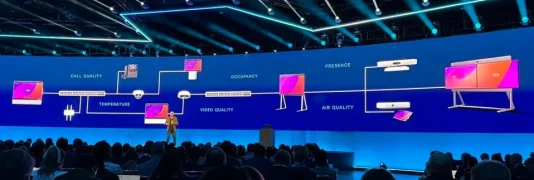 You’ll notice my friend James Myers, from Intel, when you inevitably see him roaming the halls of your next tech conference. He’s hard to miss, with a warm smile and distinctive bow tie that draw you instinctively closer. If it’s his friendly demeanor that attracts you, it’s the depth of his passion for a specific set of technologies that holds your attention. James is a man on a mission. Just let him talk to you about Intel Optane.
You’ll notice my friend James Myers, from Intel, when you inevitably see him roaming the halls of your next tech conference. He’s hard to miss, with a warm smile and distinctive bow tie that draw you instinctively closer. If it’s his friendly demeanor that attracts you, it’s the depth of his passion for a specific set of technologies that holds your attention. James is a man on a mission. Just let him talk to you about Intel Optane.
Optane’s promise
Intel’s Optane persistent memory technology seemed set-up to fail. The expectations were simply set too high. From the outset, it was described in terms that sounded too good to be true. Based on a new semiconductor technology that its inventors at Intel and Micron Technologies dubbed 3D XPOINT (pronounce that “3D cross-point”), it was designed to overcome the limitations of traditional NAND-based SSDs. The technology is also blindingly fast, with near-zero access latencies. Optane was designed as the ultimate storage media.
Optane, like 3D NAND before it, provides persistence. Optane takes a different approach from NAND, though, exposing persistence with a byte-level addressability that’s more akin to how memory is used than how traditional SSDs are usually accessed. It’s that byte addressability, coupled with those nearly non-existent latencies, that give Optane its magical powers.
When Intel first introduced an Optane SSD in 2017 it made the strategic mistake of letting its consumer marketing teams sell the device. An Optane SSD could speed up the disk accesses of your next game of Call of Duty, or make your video editing run a little smoother, but it came at an early adopter cost that consumers weren’t quite ready to swallow. The new semiconductor technology committed the dual sins of being both more expensive than 3D NAND, while also delivering less capacity. The home PC market thrives on the promise of more for less, and the reviews in the consumer technology press were unkind.
The problem, as James will tell you, was that the technology was misunderstood and a victim of its own hype. Try thinking about it this way: instead of replacing 3D NAND SSDs, Optane introduces a new storage tier into your system’s architecture. The guys in Silicon Valley who like to make up acronyms call it Storage Class Memory, or SCM.
Optane SSDs are for your hot storage. Data that needs persistence, but data that also needs to be accessed quickly and frequently. If you need something hotter than hot, then there’s Optane DC Persistent Memory. Intel Optane PM exploits the byte-addressability of the technology and puts Optane into a DIMM slot, right next to your main memory and CPU. Traditional NAND-based SSDs don’t go away—rather, they become the repository for your workaday storage. Behind those fall traditional hard-drives (and soon-to-be QLC NAND SSDs).
The problem is that this new storage tiering doesn’t just happen when you plug in an Optane device. It requires a system engineered to accept it, along with software intelligent enough to understand what data is hot enough for Optane. It’s a hard problem to solve. If you watched the storage market in 2018, you noticed nearly every storage vendor touting their arrays as “SCM Ready,” but with a fair amount of hand-waving in terms of what it all really meant. The storage vendors who have implemented SCM, such as Hewlett Packard Enterprise , in its 3PAR line, are using the technology primarily for read caching. This still provides a benefit, but not the level that full use of the technology as a persistent memory store would yield.
The hand-waving about SCM can now end. This week Dell Technologies opened its garage door and demonstrated to the world what a souped-up SCM-enabled array can do.
PowerMax: Intelligent Storage
Dell introduced its PowerMax storage architecture just last year at its Dell Technologies World conference in Las Vegas. A powerful beast of a machine, the PowerMax delivered the full potential of an all-flash system enabled with latency-killing NVMe. It yielded performance numbers that pushed the limits of what was achievable in a storage array. During its introduction at the conference, Dell’s Jeff Clarke said that Powermax had “artificial intelligence” within it to help “adapt” to the workloads it was servicing. Nobody from Dell mentioned SCM, but I still walked away with that familiar feeling of having watched a marketer’s hands waving.
This past week Dell announced an updated PowerMax, with features that make it quite clear where its embedded AI is focused. It’s also a textbook illustration of the benefits of properly-tiered Optane memory. The PowerMax now supports dual-ported Optane SCM. To unlock the power of Optane, the PowerMax’s artificial intelligence engine watches data patterns and makes decisions about which data belongs in SCM and which belongs on NAND-based SSDs. This is similar to how a hybrid-flash array provides SSD-like speeds by intelligently placing hot data on SSDs and colder data on spinning drives (but without the spinning drives).
The machine learning engine in the PowerMax isn’t just about intelligent data placement. The software also makes decisions that keep its performance at steady levels by, for example, temporarily disabling in-line deduplication during busy periods. The AI engine will also enforce rules and perform dynamic tuning to meet application SLAs that the storage administrator defines.
Beyond intelligently tiering Optane SCM and traditional SSDs, Dell added NVMe-over-Fabric to its offering. The PowerMax now supports 32Gbps FC-NVMe to bring low-latency clustering between controllers. This continues a trend that we’re seeing across the industry, with Fibre Channel a natural early target for NVMe interconnect. There’s a lot of expensive existing SAN infrastructure out there, and this is great path forward to maintain that investment.
The only real measure of a product like this is in its performance numbers. Does Optane and machine learning-based tuning make a difference? Dell’s numbers seem to suggest that it does. In one published benchmark, the inclusion of Optane delivered 26% lower latency, showing a 0.21 ms response time on a 100K IOPS random read workload. The big win, though, is in write performance. A write-intensive mixed workload showed that Optane outperformed traditional SSDs by nearly 500% (that’s not a typo).
If you’re interested in raw numbers and the nitty-gritty of the benchmarks and capabilities of the new PowerMax, it’s all here on Dell’s website to find.
Wrapping up
Dell’s PowerMax is an impressive family of devices. The introduction of its latest models is well-timed, landing a week ahead of Pure Storage’s annual Accelerate Conference, and just days before IBM showed off its new mainframe-class array. I’m sure both marketing teams had an uncomfortable day updating their competitive analysis charts.
Pure Storage is expected to announce updates to its product line-up this week at Pure Accelerate. We don’t know yet what will be announced, but there’s already strong speculation in the technology press that it will include adoption of SCM technology. Optane is quickly finding a home in storage systems.
Optane’s time is near. While the Dell EMC PowerMax nicely demonstrates what the technology can do in a storage array, the developers of memory-intensive software are also beginning to show off the potential of Intel Optane DC Persistent Memory in application architecture. For example, Optane in a DIMM slot shows recovery times for applications like SAP HANA that are orders-of-magnitude faster than what is achievable with SSDs. Persistent memory sitting next to the CPU changes the conversation about what it possible, whether for databases or big key-value stores.
I haven’t talked to James since Dell released its new PowerMax, but I imagine he’s smiling brighter, with his tie straightened up just a little bit. Dell’s demonstration of how Optane should be used has made his job a little easier. If you want to know where else Optane is changing the world, just ask him—he’s easy to pick out. Look for the bow tie.





















































































